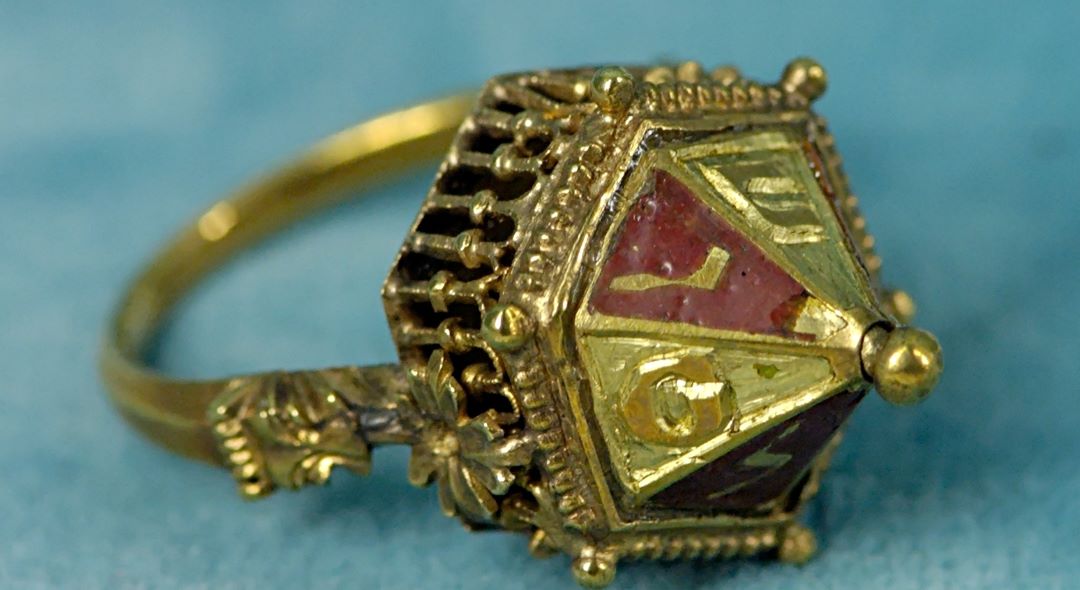Surprising History Of The Wedding Rings December 18, 2020 – Posted in: Blog
Wedding ring is an emotionally loaded purchase. For most of us, it’s more than just jewellery: it’s a symbol of eternal romance, as well as the lifelong commitment we’re planning to make. It’s recognisable in just about every culture and has represented the circle of life for centuries. But what’s less known is that this humble accessory has fantastical origins.
Have you ever wondered: Why a ring? Where did today’s wedding ring traditions come from, and when did it start? Ever wonder “why gold and diamonds?” Well, wonder no more, here is a quick rundown of the history of wedding rings, and a quick explanation of the meaning behind today’s wedding ring traditions.
ORIGIN OF THE WEDDING RING
The history of wedding rings dates almost 5000 years. During ancient Egypt times, people would weave leather or wood and exchange them as “rings of love.” The ring itself, being round with no end, was a powerful symbol of eternity.
The exchanging of rings is one of the oldest marital traditions around. One version of the origin of the wedding ring states that, during prehistoric times, the groom would bind the bride’s ankles and wrists with grass, to keep her soul from escaping (some say it was really to keep her from running away!). Once the ceremony was complete, he would remove the rope, and tie it to one of her fingers. This tradition gradually evolved from grass, to rope, to leather, and finally, to a metal band.
Another story came from the The Ancient Romans, who believed in the vena amoris, meaning “vein of love,” theorising that the heart’s blood supply ran directly to the third finger of the left hand.
Since then, wedding rings have been worn on the third finger, now commonly referred to as the “ring finger”—although some cultures choose to wear wedding rings on the right because that’s the hand typically used for making sacred oaths and vows.
FUN FACT – Even though South Africans wear their diamond engagement ring on their left-hand ring finger, most European couples wear their rings on their right hand. Why? The theory has it the ring will get less damaged due to most people being right-handed.
Iron rings were given to brides to symbolise unity between the wife and the husband
WHEN DID MEN START WEARING WEDDING RINGS?
Up until the past century, wedding rings were mostly worn by women, although the Christian church promoted exchanging wedding rings as a way of keeping men faithful. Dual rings only caught on during WWII when American and European soldiers wore wedding rings as a way to remember their wives and sweethearts back home. The tradition continued through the Korean War. After this, wedding rings for men caught on among civilians as well.
WEDDING RINGS THROUGHOUT THE HISTORY
GIMMEL RINGS
Gimmel rings featured two or three hoops that fit together to form one ring. After getting engaged, the man and woman would each wear one part of the ring, then during the wedding ceremony they’d reconnect their bands and the bride would wear the unified ring.
Gimmel rings functioned much like engagement rings or promise rings today. The difference is that while traditionally it’s common only for the female to wear the ring, here both the man and the woman wore one of the loops during the engagement. On some occasions, gimmel rings were given as friendship rings between men.
JEWISH MARRIAGE RINGS
Wearing a wedding band with an unbroken circle made in solid silver or gold is a long-standing Jewish tradition. It symbolizes everlasting marriage. Bands with no details or stones are symbolic of a strong marriage that is free from complications and distractions.
These Jewish wedding rings date back to at least the 10th century. And, they continued to remain popular until the 19th century. By then, they’d become intricate designs with enamel and lattice.
It features a “roof-like” top, which represents the Jewish temple or the married couples’ home. Designed like lockets, they feature Hebrew inscriptions on the inside. Grooms offered them to their brides during the marriage ceremony as a symbolism of love and unity.
FEDE WEDDING RINGS
These wedding rings held their popular ground for more than a thousand years in Europe. They eventually evolved into styles featuring interlocking bands and ornate patterns.
Today, the Irish still wear a style of this wedding band called a Claddagh ring. It features two hands coming together to hold a heart with a crown. The Claddagh ring was first created about 13 centuries after Rome introduced the original fede rings.
Also Read: Crave Your Memories For A Priceless Gesture With The Photo Engraved Coins
LOVERS HEAD WEDDING RING
The Romans started customizing wedding rings with their own personal touches. Lovers heads rings featured carvings of the faces of the couples themselves. Some were carved with the full figures of the bride and groom.
Once the Empire proclaimed Christianity its official religion, things switched up a bit. The carvings started to feature the couple with a cross or Jesus behind them blessing their unity.
POSY WEDDING RINGS
What is a posy? Also known as a posie, it’s a short verse engraved on a ring, often a poem. Posy rings first became common during the 15th century. It all began with bold designs featuring words engraved outside the wedding band.
The designs of the posy rings evolved into simpler ones. However, the engraved words became more and more personal. This caused goldsmiths, ring makers, and jewelers to learn how to engrave inscriptions on the inside of the wedding rings. They believed this kept the message close to the person wearing it while keeping them private.
HOW ARE THE WEDDING RINGS WORN TODAY?
Only a hundred or so years ago, only brides would traditionally wear wedding rings. But like so many things, two world wars changed all of that. Soldiers heading off to battle wanted something always on hand to remind them of who was waiting for them to come home. As a result, it’s become standard that both partners now wear wedding bands.
As for what fingers wedding rings are worn on, most people in the Western Hemisphere and parts of Europe wear their wedding rings on the ring finger of their left hand. Part of this is tradition (thanks to the Vena Amoris), but there’s likely a utilitarian angle to this as well; most people are right-handed, and it makes sense to wear your multi-thousand-dollar ring on the hand that isn’t quite as active. But the fourth finger, left hand, isn’t totally universal.
In some countries, for example, couples tend to wear their wedding rings on their right hands. This holds true for Russia, Poland, Norway, Austria, Denmark, Latvia, Bulgaria, Ukraine, Spain, and India. Greek couples have traditionally worn rings on the right hand, but left-hand rings are becoming more prevalent. And then there are countries such as Brazil, Germany, and the Netherlands where couples will wear plain bands as engagement rings on one hand, and then switch them to the other hand once they’re married.
And finally, as tradition gives way to newer needs and customs, people around the world are choosing for themselves how, where, and when to wear their wedding rings. After all, it’s your marriage; you determine what works best for you.
MODERN DAY WEDDING RINGS
Today, most couples continue to exchange wedding rings to symbolize their unity and commitment. While gold still remains the classic wedding band choice, there are many other alternative metals choices as well. This allows couples to personalize their ring even more based on their budget and other preferences.
Also Read: Trendy Ways To Pair Indian Jewellery With Western Outfits
THE FUTURE OF THE WEDDING RINGS.
Throughout history the wedding ring was mandatory in many cultures, especially for women, as it signified that marital status of the person and marked them as ‘off the marriage market’.
Today, wearing a wedding ring is a choice. Unless your part of a religion where wearing a ring is mandatory, you and your partner can choose whether or not you want to wear a wedding ring. There are no hard and fast rules about this. And if you decide not to wear one, no drama. That’s totally up to you.
Having said that, the majority of couples getting married choose to wear wedding rings, paying homage to an ancient tradition.
The custom of wedding rings has endured for millennia and it’s very likely that this will not change possibly for thousands of years more. While the styles and designs of wedding rings will continue to evolve and change to reflect the times they’re in, the overarching meaning of a wedding ring will not change.
As long as couples fall in love and get married, the symbolism of the wedding ring will continue to be relevant. And as long as it’s relevant, wedding rings, it’s safe to say, will continue to endure.
AuGrav (Au-Gold, Grav-To Etch, to Engrave) Strongly believes that any Jewel should be a natural extension of yourself. It could be as simple as your Names, to your Fingerprints, your Voice Waves, or anything that describes your Persona. To create a piece that will be worn by only 1 out of 7 billion people on earth, Get In Touch with us. Our Jewelry experts have all ears to listen to your story and suggest creating a masterpiece.
















